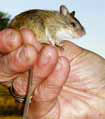Intro to Ogmius Exchange
Preble’s Meadow Jumping Mouse
 The Preble's meadow jumping mouse (Zapus hudsonius preblei) (Preble's or PMJM), a small approximately 9-inch long rodent, was listed as a threatened species under the Endangered Species Act in 1998. Preble’s habitat is in fragile riparian areas along the eastern side of the Rockies. Consequently, developers claim, the mouse’s ESA protection has blocked or impeded millions of dollars worth of development along the Front Range. All of that may soon change as the U.S. Fish and Wildlife Service recently proposed to delist the Preble’s. This decision is based upon a report by Ramey et al. finding that the mouse is not a discrete taxonomic entity, does not meet the definition of a subspecies, and was listed in error.
The Preble's meadow jumping mouse (Zapus hudsonius preblei) (Preble's or PMJM), a small approximately 9-inch long rodent, was listed as a threatened species under the Endangered Species Act in 1998. Preble’s habitat is in fragile riparian areas along the eastern side of the Rockies. Consequently, developers claim, the mouse’s ESA protection has blocked or impeded millions of dollars worth of development along the Front Range. All of that may soon change as the U.S. Fish and Wildlife Service recently proposed to delist the Preble’s. This decision is based upon a report by Ramey et al. finding that the mouse is not a discrete taxonomic entity, does not meet the definition of a subspecies, and was listed in error.
This month’s Ogmius Exchange uses the Preble’s controversy as a lens through which to examine more broadly the role of science in policy decisions. The author is Anne Ruggles, a wildlife biologist, attorney, and Visiting Scholar at the Center who has been actively engaged in research with Preble’s including population estimates, determining distribution, radiotelemetry, and writing management recommendations and plans.
For more information see:
Holthouse, David, 2005: “Building a Better Mousetrap.” Westword, Jan. 20-26, pp. 19-25, and responses in the Jan. 27 – Feb. 2 issue at p. 6.
Johnson, Kirk, 2004: “Debate Swirls Around the Status of a Protected Mouse.” New York Times, June 27.
Martin, Andrew, 2004: “Good science trumps advocacy: Genetic study of Preble’s mouse flawed, no basis for change in protected status.” Daily Camera, August 1.
U.S. Fish and Wildlife Service Mountain-Prairie Region, Endangered Species Program – Preble’s Meadow Jumping Mouse page.
See also the May 2002 Ogmius discussion of the Data Quality Act, which touched on some of the same issues that are raised in the Preble’s case.

